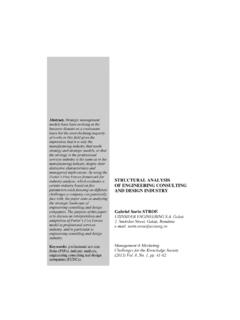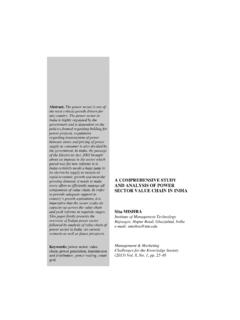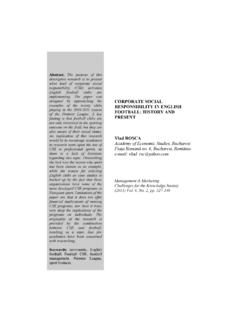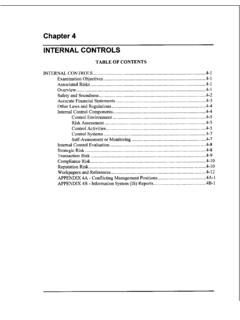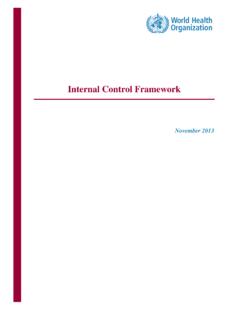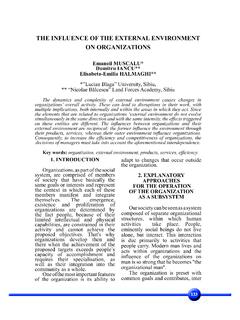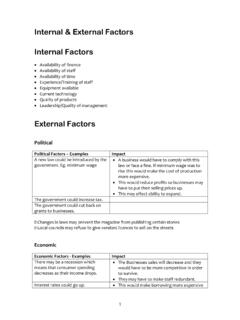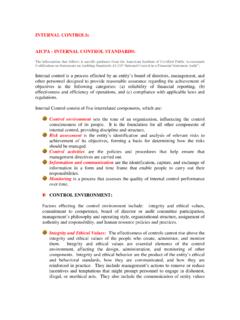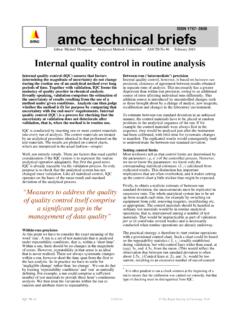Transcription of THE INTERNAL AND EXTERNAL ENVIRONMENT ANALYSIS …
1 Management & Marketing (2009) Vol. 4, No. 3, pp. 97-110. THE INTERNAL AND EXTERNAL ENVIRONMENT ANALYSIS OF romanian naval INDUSTRY WITH SWOT MODEL Carmen GASPAROTTI Dun rea de Jos University of Gala i Abstract. SWOT ANALYSIS is an effective method used for strategic planning to identify potential, priorities and creating a common vision of achieving the development strategy for a company. This should answer the question Where are we? involving the ANALYSIS of the INTERNAL and EXTERNAL ENVIRONMENT generally and specifically. It used to evaluate the company ENVIRONMENT factors. Only by taking into consideration the components of general ENVIRONMENT : economic ENVIRONMENT , social ENVIRONMENT , political ENVIRONMENT , legislation and pressure groups, a company will be able to adopt the particular way of action, which will assure its performance and advantages on present and potential competitors.
2 Keywords: opportunities, strengths, threats, weaknesses 1. Introduction SWOT model (Strengths, Weakness, Opportunities and Threats) represents the established instrument used to analyze the INTERNAL and EXTERNAL ENVIRONMENT , which a company functions in. Based on this model, the company s strategies can be formulated by combining INTERNAL ENVIRONMENT factors, which are: strengths and weaknesses, with EXTERNAL ENVIRONMENT factors: opportunities and threats. A good knowledge of the ENVIRONMENT , the interrelations between this one and the organization, its evolution, represent the base of politics and strategies elaboration and also, may be considered as a main condition for an efficient activity of the organization.
3 Speaking about the strategically answer of the company towards competitive ENVIRONMENT , Reason showed that this answer has to satisfy three criteria to be adequate to competitive ENVIRONMENT pressures; to be satisfactory to shareholders; to be reliable, which means the company must have the necessary abilities and resources in order to generate the strategically answer asked for. Strengths and weaknesses of the organization, INTERNAL ENVIRONMENT , are important for resources, programs and organization in key points such as (Catrinescu, 2002): sells/marketing/distribution, management system/survey report, production efficiency/capacity, products /quality/price. Management & Marketing 98 The opportunities and threats that a company confronts with may exist or may develop in the next points: the own company industry where structural changes may be produced; the market place, which can be deteriorated by economical and social factors; competitiveness, where new dangers and opportunities may appear; new technologies that may cause fundamental chances of products, processes etc.
4 ; The achievement and practical use of SWOT ANALYSIS require the following steps (Catrinescu, 2002): to identify strengths and weaknesses, as well as opportunities and threats; to identify SWOT quadrant; to formulate the concrete strategy. SWOT quadrant identification can be realized in two different ways: By placing the strategy, based on the elements of INTERNAL and EXTERNAL ENVIRONMENT of the company, in one of the four quadrants of SWOT model; this placing is intuitively made by strategically managers and is applicable only to small companies; By placing the strategy in one of the four strategically quadrants of SWOT model using the evolution matrix of company s INTERNAL and EXTERNAL factors, which consider the importance coefficients j and marks of each Nj factor that are used to calculate their weighted marks j Nj and, finally, the weighted score for all jjN factors.
5 Since SWOT quadrant is identified, the concrete strategy of the company can be formulated and that will depend on the company s concrete conditions. SWOT ANALYSIS , as a model of total diagnosis, is also used to find out the economical and financial situation of a company. This ANALYSIS includes Opportunities of favorable chances which are considered to be the events and processes produced in the macro- ENVIRONMENT and competitive ENVIRONMENT that create favorable conditions for local naval industry to function and develop; Threats or dangers which are considered to be the factors and events pro-duced in the macro- ENVIRONMENT and competitive ENVIRONMENT that create unfavorable conditions for local naval industry to function and develop; Strengths, represented by resources and abilities in fields such as: marke-ting, finance, human resources, technology and production, organization and management, that give emphasis to the local naval industry.
6 Weaknesses represent those aspects of local naval industry function in fields like marketing, finance, human resources, technology, production, organization and management that limit the efficiency or prevent the development of local naval industry. The INTERNAL and EXTERNAL ENVIRONMENT ANALYSIS of romanian naval industry 99 For this purpose diagnosis are synthesized on components (production, quality, competition, rate of turnover, financial situation, management, staff etc.), by pointing out the strengths and threats of company s activity, as well as the malfun-ctions and their causes that may appear in the company s activity. The ANALYSIS uses scores system which allows calculating an average mark based on which the company may be placed in one of the following situations: economical viable or non-viable.
7 2. romanian naval industry evolution during the last years romanian naval industry has 12 shipyards, 9 of them are centered on shipbuil-ding and 3 of them on repairs. Regarding the employees number the size of these 12 shipyards is the following: 1 shipyard with more than 5000 employees (SN Damen Galati); 3 shipyards with 3000-5000 employees; 3 shipyards with 1500-3000 employees; 5 shipyards below 1500 employees. The large number of employees from romanian Shipyards is due to high level of production integration, which can be compared with the level in Japan and Korea. This level is different from those in European shipyards, which generally exercise subcontracting. In UE the most shipyards have below 1000 employees. Only 17 shipyards have a number of 1000-2000 employees and 28 large shipyards have together 64 000 employees (AWES, 2005).
8 From achieved production, because the INTERNAL market does not offer opportunities due to the capital lack, the ship production was orientated to the export, its weight has increased from year to year, reaching to represent 99% from total production of 2008 (ANCONAV, 2000-2008) (Figure 1). Figure 1. The export weight in total naval production Management & Marketing 100 The evolution of shipbuilding production and repairs during 2000-2008 is presented in Figure 2. Figure 2. romanian naval industry during 2000-2008 During 2000-2008 romanian naval industry had an increasing evolution (Figure 3). Figure 3. The evolution of ship production value in Romania Shipyards build maritime ships and river vessels, the production being concentrated on ships such as: bulk carrier, port-containers, cargo tankers, LPG, and LNG, chemical tankers, Ro-Ro, coastal fishing ships.
9 The INTERNAL and EXTERNAL ENVIRONMENT ANALYSIS of romanian naval industry 101 Romania had 2,4% from international orders portfolio in cgt (compensated gross ton) at (ANCONAV, 2003-2008). Considering the ship type, the weight is the following: 0, 9 % tankers; 2,2 % bulk-carriers; 0,1 % port-containers; 5,6 % cargo. Work productivity in romanian shipyards is below the eastern European shipyards level (Stranschi, 2002; ANCONAV, 2003-2008) (Table 1). Table 1 Work productivity for romanian naval industry Romania Work productivity (hours-men/tonne) 2000-2002 2003-2005 After 2006 Western Europe Total, from which: 200-140 140-90 80 40 hulls plant painting 100-70 75-40 25-20 70-45 50-35 20-15 35 25 10 19 13 8 For the year 2006, the forecast announces that the romanian productivity will reach the Western European level, as a result of modern technologies and IT systems.
10 As a condition to UE accession, the average work productivity will have to become at least equal with average work productivity of shipyards from the whole world, which is 88 hours/men/cgt (CESA, 2006-2007). In the international industry and economy, naval industry has a modest place, by its weight in the industrial production value, PIB industry, active population and export (Table 2). Table 2 naval industry in romanian economy Indicators Year Percentage Weight to active population in industry 2006 2007 1,02 1,15 Weight to active population in the whole economy 2006 2007 0,178 0,15 Weight to industrial production value 2006 2007 0,712 0,715 Weight to PIB industry 2006 2007 1,08 1,12 Weight to industry s export 2006 2007 2,49 2,5 Weight to romanian total export 2006 2007 2,2 2,3 Management & Marketing 102 Considering the gradual increasing of maritime trading, as a result of the world economical growth and the ship volume, which are to be disablement and lost.
